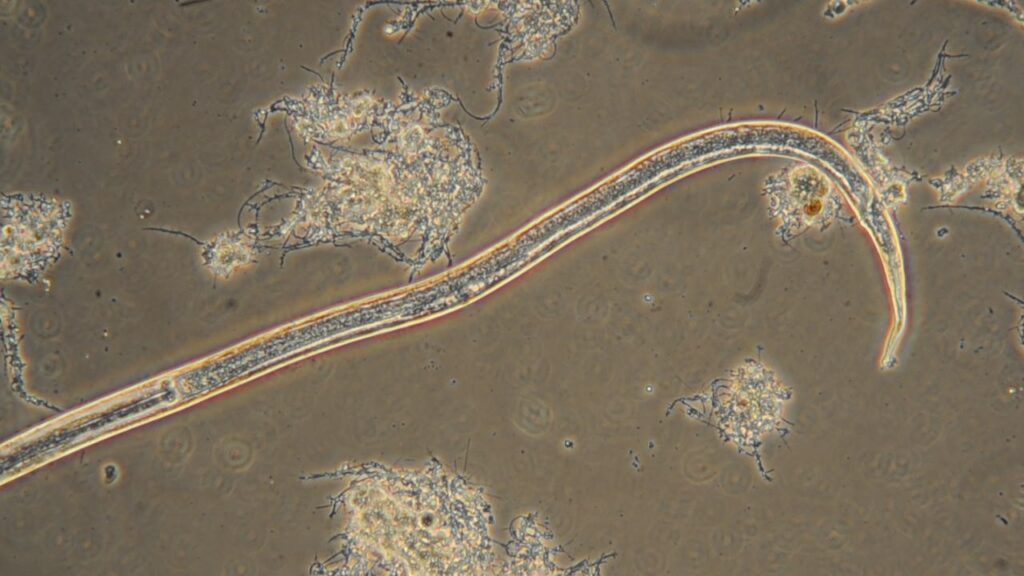
Nematodes in microscopic exam indicate endogenous conditions.
As wastewater professionals, we’re all familiar with the activated sludge process—the backbone of many treatment plants. But one aspect that often flies under the radar until it causes issues is endogenous phase biomass, commonly referred to as “old sludge.” This occurs when sludge ages in the system, shifting from active growth to a maintenance mode where microbes start breaking down their own cells. In this post, we’ll dive into what endogenous phase biomass really means, the problems it can create, and why maintaining it comes with a hefty price tag—particularly due to the need to keep solids aerobic.
What Is Endogenous Phase Biomass?
In a typical activated sludge system, microorganisms thrive on incoming organic matter (like BOD or COD) during the growth phase, rapidly multiplying and treating the wastewater. However, when the food source dwindles—often in extended aeration periods or due to low influent loads—the bugs enter the endogenous respiration phase. Here, they metabolize their own stored energy reserves and cellular material to survive.
“Old sludge” is essentially biomass that’s lingered too long in this phase. It’s characterized by a higher solids retention time (SRT) than optimal, leading to a decline in active, viable cells. While some endogenous activity is normal and even necessary for sludge stabilization, excessive old sludge can disrupt the balance of your treatment process.
The Problems Associated with Old Sludge
Old sludge isn’t just inert material taking up space; it actively contributes to operational headaches. Here are the key issues wastewater pros should watch for:
- Reduced Treatment Efficiency
With fewer active microbes, the system’s ability to remove organics and nutrients drops. This can lead to higher effluent BOD, ammonia, or phosphorus levels, risking permit violations and environmental impacts. - Poor Sludge Settling and Thickening
Endogenous decay produces extracellular polymeric substances (EPS) that can cause sludge bulking or foaming. Filamentous bacteria often proliferate in old sludge environments, resulting in high sludge volume index (SVI) and clarifier overflows. - Increased Sludge Production and Handling Needs
Paradoxically, while cells are breaking down, the overall sludge yield might rise due to incomplete stabilization. This means more waste activated sludge (WAS) to dewater, haul, and dispose of, driving up operational costs. - Nutrient Imbalances
Old sludge can release stored nutrients like phosphorus back into the liquid phase, complicating nutrient removal processes and potentially leading to struvite formation or algal blooms in receiving waters. - Odor and Corrosion Issues
If not managed properly, partial anaerobic conditions in old sludge can generate hydrogen sulfide (H2S) and other volatile compounds, causing odors, corrosion of equipment, and safety hazards for plant staff. - Energy Inefficiencies Maintaining old sludge requires more aeration to support the remaining microbes, but with diminished returns on treatment performance.
These problems compound in systems with variable flows, such as those in seasonal or industrial settings, where sludge age can creep up unnoticed.
The Cost of Maintaining Old Sludge: Why Aeration Matters
One of the most direct financial hits from old sludge comes from the imperative to keep solids aerobic. In the endogenous phase, microbes still need oxygen to respire efficiently—without it, the process shifts to anaerobic decay, exacerbating many of the problems listed above, like odors and poor settling.
Aeration isn’t cheap. Blowers, diffusers, and mixers consume a significant portion of a plant’s energy budget—often 40-60% of total electricity use. For old sludge, you’re essentially aerating a larger mass of less productive biomass. This means:
- Higher Energy Consumption
To maintain dissolved oxygen (DO) levels (typically 1-2 mg/L), you need continuous aeration, even when the organic load is low. Old sludge has a lower specific oxygen uptake rate (SOUR), but the sheer volume requires sustained input, leading to inflated utility bills. - Equipment Wear and Maintenance
Prolonged operation of aeration systems accelerates wear on motors, bearings, and diffusers. Fouling from EPS in old sludge can reduce diffuser efficiency, necessitating more frequent cleaning or replacements. - Opportunity Costs
Resources spent on aerating old sludge could be redirected to optimize other processes, like advanced nutrient removal or energy recovery from biogas. In essence, you’re paying to sustain a suboptimal system rather than investing in efficiency upgrades.
Quantifying this, studies from the Water Research Foundation estimate that excessive SRT can increase aeration energy by 10-20% in affected plants. For a mid-sized facility, that could translate to thousands of dollars annually—funds better spent on proactive sludge management, like automated SRT controls or sidestream treatment.
Wrapping Up: Strategies for Better Sludge Management
Endogenous phase biomass is a natural part of the wastewater treatment cycle, but letting sludge get too “old” invites inefficiency and expense. By monitoring SRT, MLSS, and SOUR regularly, you can strike a balance—typically aiming for an SRT of 5-15 days depending on your plant’s design and goals. Consider tools like respirometry or advanced modeling to predict and prevent old sludge buildup.
If you’re dealing with these issues at your facility, share your experiences in the comments. Let’s keep the conversation flowing toward more sustainable, cost-effective treatment.
